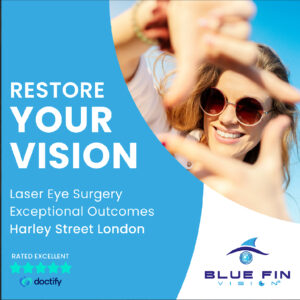Refractive lens exchange (RLE) has become a game-changer in the field of vision correction, particularly for those who experience age-related vision issues, such as presbyopia, and those who are not suitable candidates for laser surgeries like LASIK. This advanced surgical procedure is an appealing alternative to traditional methods of vision correction, as it provides a long-term solution to refractive errors, offering patients the opportunity to achieve clear vision without the need for glasses or contact lenses.
Unlike LASIK, which reshapes the cornea to improve the way light enters the eye, RLE works by replacing the natural lens of the eye with an artificial intraocular lens (IOL). The IOL can correct a wide range of vision problems, including myopia (nearsightedness), hyperopia (farsightedness), astigmatism, and presbyopia (the inability to focus on close objects with age). By removing the natural lens and replacing it with a highly specialized IOL, the procedure can treat both distance and near vision problems simultaneously, making it a particularly attractive option for people who want a comprehensive solution to their vision needs.
The ability to address multiple vision problems with one procedure is one of the significant benefits of RLE. Many individuals experience a combination of presbyopia and other refractive errors as they age. For example, someone who is both nearsighted and struggling with near vision due to presbyopia may find RLE to be the ideal solution. The Refractive lens exchange advanced IOLs available today, such as multifocal and accommodating lenses, allow for a broader range of vision, from close-up reading to distant vision, eliminating the need for bifocals or reading glasses.

Another advantage of RLE is its durability. While corrective eyewear such as glasses or contact lenses can require ongoing maintenance and adjustments, the IOL inserted during RLE is a permanent solution. Once in place, the IOL typically lasts for the rest of the patient’s life, providing them with stable vision. This makes RLE particularly appealing to those who are tired of continually changing prescriptions or dealing with the hassle of glasses and contacts. Additionally, because the natural lens is removed and replaced with an artificial lens, RLE also prevents the development of cataracts, which are common as people age. This is an important consideration, as cataract surgery would likely be required in the future, potentially making RLE a two-in-one solution.
Though RLE offers a range of benefits, it is not the right choice for everyone. One key factor that influences candidacy for RLE is age. It is generally recommended for individuals over the age of 40 who are beginning to experience presbyopia or other refractive errors. However, candidates must also have healthy eyes and no other underlying eye conditions, such as retinal disease or glaucoma. A thorough eye examination is crucial to determine if RLE is a suitable option and to assess the best type of intraocular lens for the patient’s lifestyle and visual needs.
The procedure itself is minimally invasive and typically performed on an outpatient basis. During the surgery, the natural lens is carefully removed through a small incision, and the IOL is inserted into the eye. The procedure typically takes around 15 to 30 minutes per eye, and patients are usually awake during the surgery, although a local anesthetic is applied to numb the area. Most patients experience little discomfort during the procedure and can resume normal activities within a few days. However, as with any surgery, there may be a short recovery period, during which patients must follow their doctor’s post-operative instructions closely to ensure optimal healing.
The potential for RLE to significantly improve the quality of life for those with refractive errors is one of the major reasons why the procedure has gained widespread popularity. Patients who undergo RLE can enjoy clearer vision without the need for glasses or contact lenses, which can lead to a greater sense of freedom and convenience in their daily activities. Many people who have undergone the procedure report improved quality of life, particularly those who have struggled with the challenges of presbyopia and the constant need for reading glasses.
In addition to its practical benefits, RLE can offer aesthetic advantages. For individuals who may feel self-conscious about wearing glasses or contact lenses, RLE provides a permanent, hassle-free solution that allows them to enjoy clear vision without the need for corrective eyewear. This is particularly important for people who lead active lifestyles, participate in sports, or simply wish to avoid the inconvenience of glasses or contact lenses on a daily basis.
However, as with any surgical procedure, RLE does come with some risks. These include infection, swelling, or inflammation, although these are relatively rare. Some patients may also experience visual disturbances, such as halos or glare, especially in low-light conditions. It’s essential for patients to have realistic expectations and understand the potential risks and benefits before deciding to proceed with the surgery.
In conclusion, refractive lens exchange represents a highly effective and lasting solution for individuals seeking to correct refractive errors and improve their vision, particularly for those who are no longer candidates for LASIK or other laser treatments. The ability to address both near and distant vision in one procedure, along with the permanent nature of the results, makes RLE an appealing option for many. With advancements in IOL technology, patients can choose from a variety of lens options to suit their unique vision needs, making RLE a versatile and transformative procedure. However, it’s essential to undergo a comprehensive eye evaluation and consult with an experienced ophthalmologist to determine if RLE is the best choice for achieving optimal vision correction.